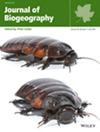Contraction and expansion: global geographical variation in reproductive systems of Primula is driven by different mechanisms
Abstract
Aim
Reproductive systems strongly influence plants' evolution and adaption, and the biogeographic pattern of its variation has intrigued biologists and ecologists. Here, to test the impacts of paleoglaciation on plants' reproductive system variation, we compared the geographical pattern and environmental drivers in the proportions of different reproductive systems in Primula in regions affected and unaffected by paleoglaciation.
Location
Global.
Time Period
Since the Last Glacial Maximum (LGM).
Major Taxa Studied
Primula.
Methods
Using data on reproductive systems and distributions of 604 Primula taxa around the world and 221 along the elevational gradient of the Himalayas, we demonstrated the global pattern and the elevational pattern in the proportions of homostylous taxa. We employed general linear models to establish the relationship between the proportion of homostylous taxa and environmental variables and hierarchical partitioning to assess the relative contributions of these variables in both regions affected and unaffected by paleoglaciation, respectively.
Results
We found a higher proportion of homostylous taxa in regions glaciated during the LGM than those unglaciated, with different latitudinal patterns and climate drivers. The proportion of homostylous taxa showed varying trends across different regions: increasing with latitude and temperature anomaly in glaciated regions while concentrating at lower latitudes with higher winter temperatures in unglaciated regions. Additionally, homostylous taxa were more prevalent at lower elevations in the Himalayas.
Main Conclusions
Our study provides the first quantitative evidence for the hypothesis that selfers are more prevailing in regions affected by paleoglaciation facilitated by recolonization via comparing the geographic pattern and drivers in regions affected and unaffected by paleoglaciation. Our findings also reveal the concentrated distribution of homostylous taxa in Primula at low latitudes, which may be the result of population shrinkage caused by heat stress, facing a more severe survival crisis under the circumstances of global warming and increasing human activities.

 求助内容:
求助内容: 应助结果提醒方式:
应助结果提醒方式:


